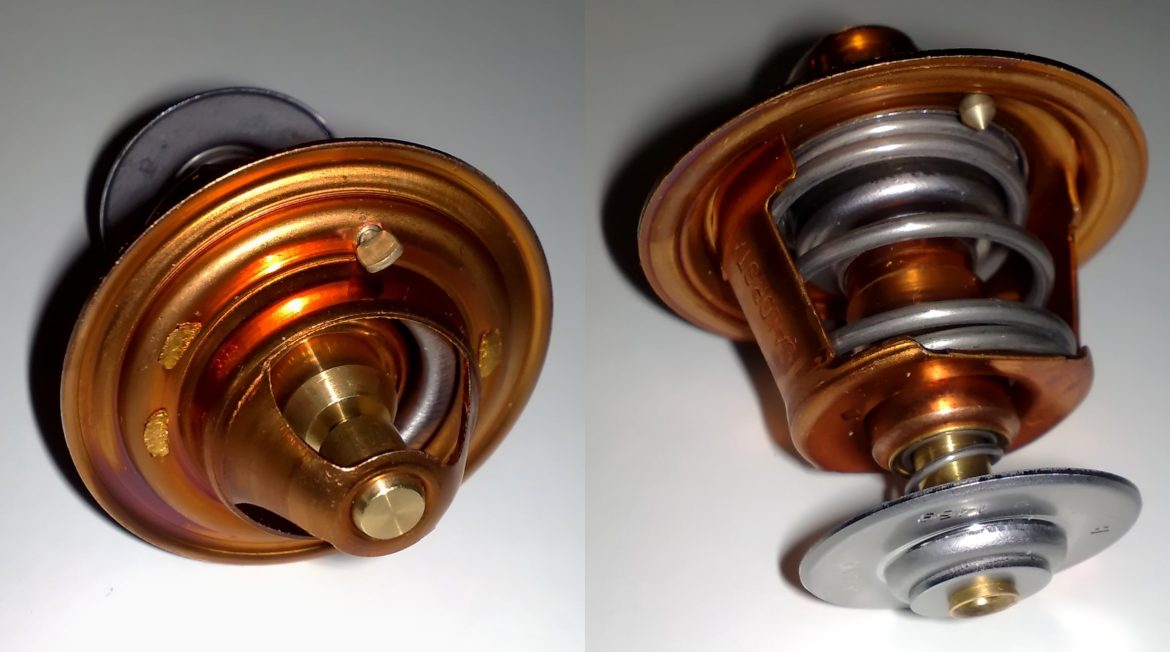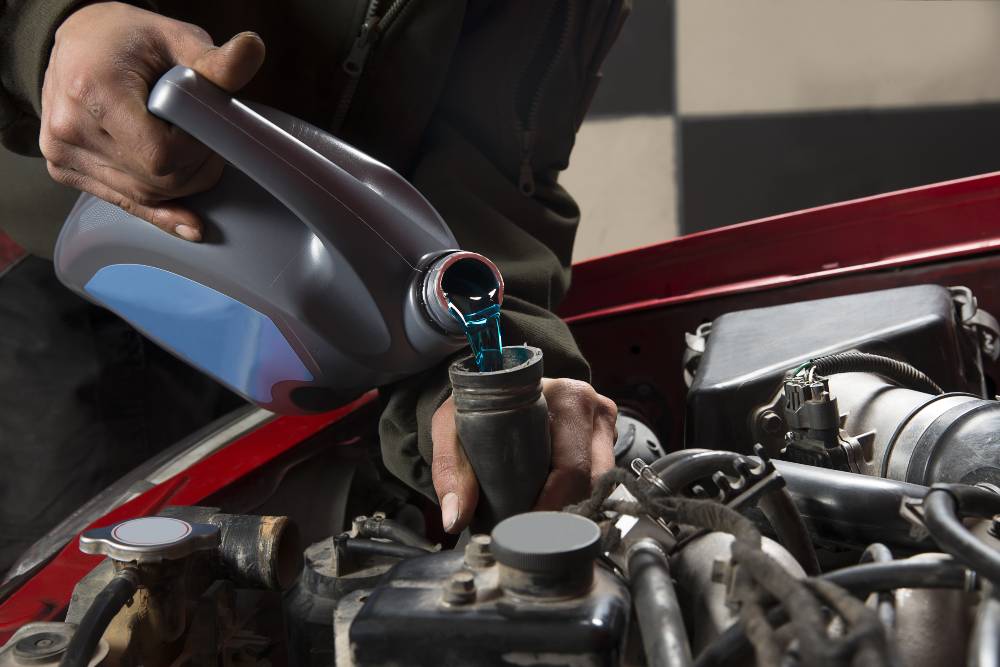Take a trip to the land of no radiators. An automobile with an internal combustion engine – with its thousands of mini-explosions an hour – produces so much heat it could melt metal and bring the entire operation to a halt. The engine would seize up within a few hundred miles of driving. This is why it’s important to determine why your radiator is leaking and how to fix it.
What a Radiator Does
Early automotive inventors devised a cooling system to extend the life of the automobile engine. In essence, a mixture of water and antifreeze is pumped through a series of hoses around the engine to absorb its excess heat and then back to the radiator where exposure to the air allows the heat to dissipate. The cycle is repeated continuously while the vehicle is in operation, keeping the engine cool enough to continue working. When the radiator is leaking fluid (or any other segment of the cooling system is leaking), the coolant level drops, reducing its ability to cool the engine.
Ordinarily, coolant circulates around the engine, through the hoses and into the radiator in a closed system. Nothing enters the system and nothing exits, a bit like the blood that pumps from your heart, around your body through arteries and veins, and back. A bodily injury that causes bleeding creates an open system into which foreign bodies can enter and cause an infection. Likewise, a break in the cooling system can cause air or debris to enter the system and cause problems.
Why Your Radiator Is Leaking
What causes a radiator leak? Here are the main culprits:
1. Corrosion in the radiator
As the radiator ages under the constant stress of pressure and heat, it begins to wear and break down. Rust, corrosion and microscopic cracks begin to develop and allow air and sediment to enter and gouge larger holes. Eventually the holes get large enough to allow for the outflow of fluid. Replacing a car radiator can cost $600-$900, in a truck it may be a couple of hundred dollars more. The radiator itself is about $100 of that.
2. Wear in the radiator gasket
The gasket that seals the connection between the radiator and the tank holding the coolant can also wear, developing a weak seal that allows fluid to leak. The result is the same—coolant exiting the system and forcing the remaining coolant to work harder.
If replacing the gasket is not an option for you, invest in a $25 bottle of BlueDevil Radiator and Block Sealer. The easy-to-use formula permanently repairs radiator gasket leaks. After allowing the engine to cool, start the engine and run the heater full blast. Slowly pour the Radiator and Block Sealer into the radiator. Replace the cap and allow the vehicle to idle for 45 minutes to circulate the sealant. If the radiator is not full, top it off with antifreeze. Any leaks should be sealed, once the 45-minute idle is complete and the engine is able to cool down. If problems with the cooling system persist, the problem may be the water pump, head gasket or something else altogether.
3. Wear in the radiator hoses
The tubes that carry coolant to and from the radiator are also subject to extreme conditions that eventually wear them down and cause them to become weak and brittle. The connections between these hoses and the radiator, water pump and heater core are all particularly vulnerable to wear and are often the primary site of the leak. Replacing a single hose costs about $150 at a service station, with labor accounting for half the cost.
4. The radiator cap is leaking
This is the one to wish for, though it is much less common than the three above. Radiator caps operate under extreme pressure and heat, which is why the engine should always be allowed to cool down before the radiator cap is removed. Even then, you should still use a rag to protect your hand from any steam that might be released.
It is critical for the radiator cap to maintain a tight seal, otherwise coolant heated to a gaseous state can seep out beneath the cap. Coolant in liquid form can escape if the opening becomes large enough. This is the easiest and least expensive problem to fix: you can spend ten bucks for a new radiator cap and easily replace it yourself.
5. The water pump has failed
The water pump pushes the coolant through the hoses to the engine and back to the radiator. Without the pump, the fluid will not circulate to cool the engine and release its heat through the radiator. Driven by a belt and hanging down near the ground, the water pump attaches to the lower hose of the radiator. If the connection with the hose loosens or the pump corrodes or gets hit by road debris, it can spring a hole that causes coolant to leak. If you see the radiator leaking from the bottom, that is often the result of the water pump.
Debris can also clog the water pump and prevent the smooth flow of coolant through it, building up pressure inside the pump and causing a breach. Even if this does not cause a leak, an inoperable water pump will not circulate coolant, allowing the engine to overheat.
A new water pump costs about $50, but the cost to replace it at a service station varies depending on how and where the pump is attached. The total cost varies from $200 to $800, with the average near the lower end.
6. The coolant reservoir tank is cracked
The plastic tank that supplies the coolant to the radiator via hoses is also subject to wear and tear. The container itself, its cap, or the connection point with hoses can all crack and begin to leak. The tank costs $150-$200; it takes about an hour of labor to replace it, for a total of $250-$300 at a service station.
7. The head gasket is blown
In the worst-case scenario, the head gasket that separates the engine block from the cylinder head corrodes or cracks, allowing gas, coolant and oil to all end up in the same place. The head gasket endures searing heat, immense pressure and the constant battering of the various fluids just mentioned. When the head gasket blows, the engine is in danger of imminent failure.
Among other problems, as coolant seeps into the engine it is less and less able to do its job and the engine can overheat. Fixing a blown head gasket is time-consuming and expensive because much of the engine must be taken apart to access it. A typical head gasket replacement costs more than $1000. Fortunately, this is much less common than leaking hoses or a corroded radiator.
If the head gasket is indeed the culprit, avoid that kind of expense with a $60 bottle of BlueDevil Head Gasket Sealer. Use of this product is identical to the Radiator and Block Sealer. It is poured into a cold engine with the engine running and heater turned up and then allowed to idle.
How to Avoid a Radiator Leak
These problems are easily avoided by occasional inspection and care of the cooling system. Because older coolant can turn acidic and wear away metal in the radiator, it should be flushed and replaced every 100,000 miles or so. See our instructions on flushing the coolant here. Check the hoses and connections for cracking and deterioration, and use the sealant to repair any damaged gaskets before experiencing any issues.
Ongoing maintenance can eliminate or head off many of the problems that lead to a radiator leaking coolant, but not all of them. All elements of the cooling system endure extraordinary pressure and temperature gradients and will eventually succumb over time.
If the leak cannot be stopped by using a sealant or the vehicle continues to run hot, bring it to your local car care professional. They have the diagnostic equipment and expertise to determine why your radiator is leaking and recommend a solution. Allowing an engine to run hot for any length of time can result in needing a whole new engine, which can cost several thousands of dollars.
BlueDevil Products can be found at AutoZone, Advance Auto Parts, O’Reilly Auto Parts, NAPA, Parts Authority, Auto Value, Bumper to Bumper and other major auto parts retailers.
BlueDevil Products can be found on Amazon.com or at AutoZone, Advance Auto Parts, O’Reilly Auto Parts, NAPA, and other major auto parts retailers.
10 responses to "7 Reasons Your Radiator Is Leaking"
10 Comments
Leave a Reply
Related Articles
Search Blog
Subscribe
Blog Categories




I just had my water pump, radiator, hoses replaced. Now I have a leak under radiator, seems to be a bolt there. Any suggestions?
Diana-
If you are still unsure as to where the leak is coming from, it may be best to have the vehicle’s cooling system pressure tested by your local mechanic to pinpoint where the loss of coolant is coming from. Once you identify the leak point, you can replace the leaking culprit.
Thank you!
-BDP
I had a coolant reservoir replaced along with a fan and all the pump clamps are tighten. But it’s still leaking coolant and now their saying it’s the radiator. Is that possible. It’s gonna cost about 900.00 on a volvo c30 2009.
Rachel-
Thank you for asking about your Volvo. Is coolant leaking to the ground? If so, the shop should be able to identify the location of the leak by putting it up on a rack and getting underneath the vehicle or performing a pressure test to identify the leak’s location. If the radiator is leaking, that is something the shop should be able to physically see.
Thank you!
-BDP
My radiator is leaking on the top and pipes are hot .they say is a thermostat but the fans are working
Thapelo-
How quickly are you losing coolant? Is the engine overheating at all? Please contact our technical support line at 888-863-0426 for further assistance.
Thank you!
-BDP
My radiator is leaking on top after fixing it. It will go down to bottom leaking again. I got a new radiator same problem continue. Fix my water pump, changed top gasket same problem continue. What should I do?
Innocent-
How quickly are you losing water/coolant? Is the engine overheating at all? Please contact our technical support line at 888-863-0426 so that we can get a little better understanding of the vehicle’s condition and be able to make any appropriate recommendations.
Thank you!
-BDP
Replaced my radiator with a new one and it is now leaking after several days. Could it be the water pump? Please need advice here. My vehicle is CRV rd5
Mackenzie-
Are you saying the new radiator is leaking? Prior to replacing the radiator, was the engine overheating at all? It’s possible an air pocket or some kind of pressure was building up to cause the leak. It does not sound like the water pump is the culprit. We’d recommend bringing the vehicle to an ASE certified mechanic for a proper diagnosis.
Thank you!
-BDP